Chinatown (Chukagai)
last update: June 01, 2021
Yokohama Chinatown, in Japanese Yokohama Chukagai, is the largest chinatown in Japan. The district began to rapidly populate with Chinese traders starting in 1859, when the port of Yokohama, one of the first in the country, was opened to foreign trade. Nowadays the Chinese residents in the area have decreased, but there are still many shops and restaurants that fill the colorful streets of Chinatown and that make this area one of the most popular in the city to spend a fun evening.
Things to see and things to do in Yokohama's Chinatown
The most interesting aspects of Chinatown in Yokohama are its atmosphere, its shops, Chinese restaurants and street food. A visit to the neighborhood in the afternoon is recommended, perhaps grabbing some snacks and eating it in the nearby
Yamashita Park by the sea, and then returning to Chinatown for dinner. The atmosphere becomes particularly magical in the evening, when the characteristic red lanterns are lit, creating a truly suggestive atmosphere. Furthermore, events and celebrations are held in the district during various Chinese holidays, and in particular during the Chinese New Year.
The most iconic buildings of the district are two Chinese temples, characterized by a more exuberant and less sober architecture than Japanese temples, and the large
entrance gates that can be seen in all the chinatowns of the world. In Yokohama there are four very large ones that delimit the whole area, the North Gate, the South Gate, the East Gate (also called Chouyoumon Gate) and the West gate. Several other gates are located at the entrance of some internal streets of Chinatown.
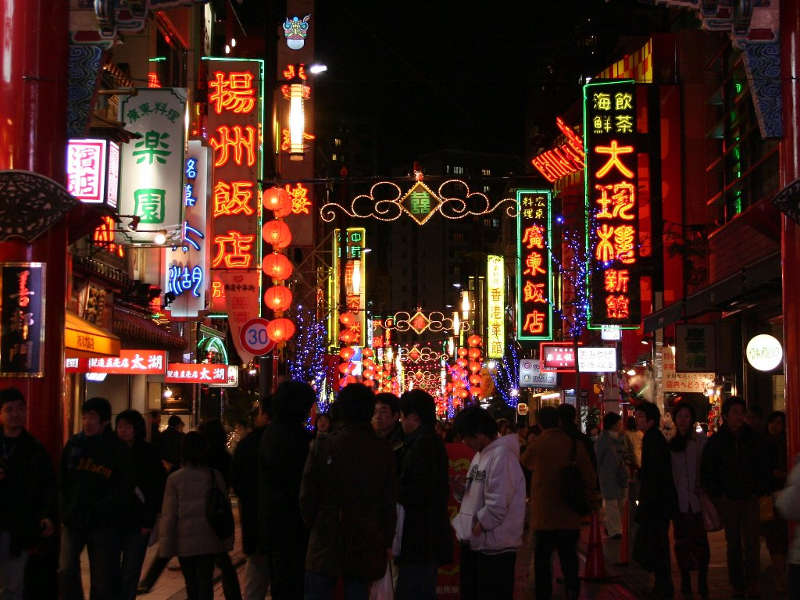 the streets of Chinatown in the evening
the streets of Chinatown in the evening
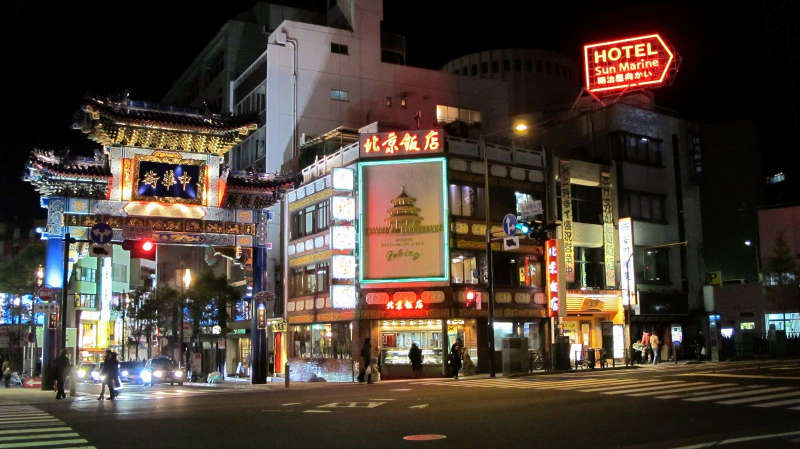 the East Gate of Chinatown
the East Gate of Chinatown
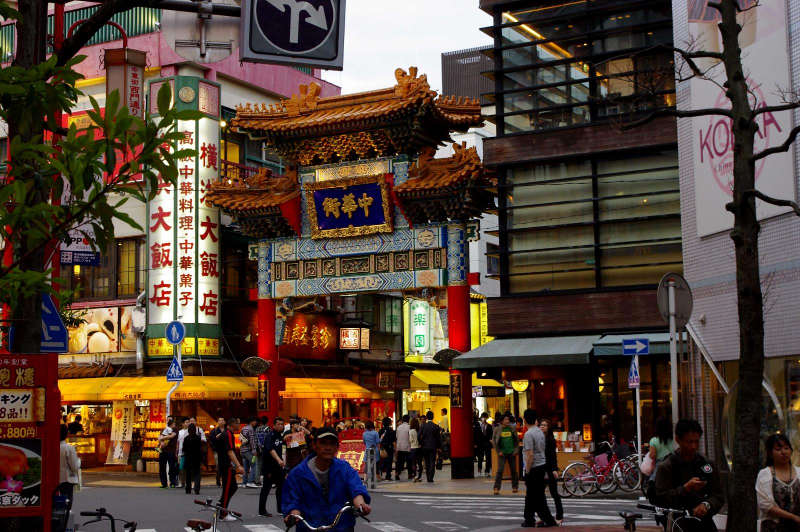 Zenrimon gate
Zenrimon gate
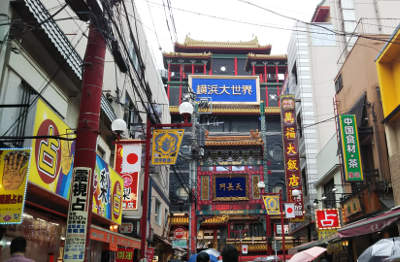
Yokohama Daisekai
Yokohama Daisekai is an eight-story shopping complex located near the neighborhood's North Gate. On the ground floor there is the largest gift shop in Chinatown. On the second floor the Yokohama Chocolate Factory&Museum, a café where you can eat dishes based on freshly made chocolate, and also observe the various stages of preparation from behind the windows. On the third floor there are acupuncture treatments and foot massages and fish pedicures (1000¥ for 10 minutes), as well as various fortune-telling services. The rest of the building (from the fourth floor up) is occupied by the Trick Art Museum (entrance 1300¥), one of those museums full of works that create optical illusions.
Temples
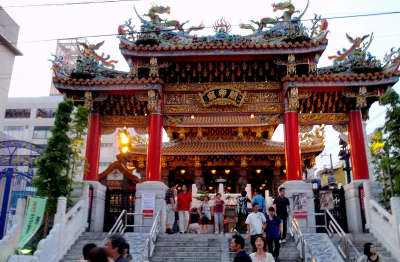
Kanteibyo Temple (also called Kwan Tai, Guan Gong Temple)
This temple is dedicated to an important hero of Chinese mythology, Guan Yu (also called Guan Gong and in many other ways), a warrior born in 162 AD who became legend for his courage, loyalty and skill in battle, now revered by the Taoists as the god of literature, war and mystical martial arts. The temple was founded in 1862 by a Chinese immigrant who brought a statue of Guan Yu with him from China, setting up a small temple around it. Reading the history of this temple it seems to be haunted by bad luck, it was in fact destroyed four times in 120 years: by the Great Kanto earthquake in 1923, by the bombing of the war in 1945, in 1981 by lightning, in 1986 by a fire. The local community, however, has never been discouraged, but, on the contrary, has each time rebuilt a larger temple than before. What we see today is quite recent, it was completed in 2000. Finally, it is worth mentioning the four large glass dragons on the roof, protecting the temple.
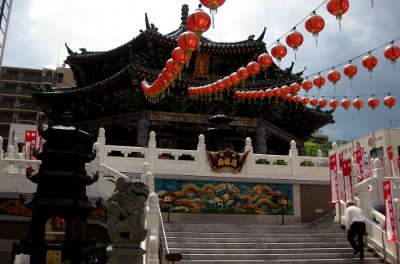
Masobyo Temple (also called Ma Zhu Miao Temple)
This temple was built in 2006 to celebrate the 150th anniversary of the city's port opening to foreign trade. It is dedicated to Ma Zhu (Mazu in Japanese), an ancient Taoist deity linked to the sea, who later became the protector of sailors and fishermen.
Where to stay near Yokohama's Chinatown
There are no hotels within the characteristic streets of Chinatown. However, in the immediate vicinity you will be spoiled for choice.
For a room overlooking the sea you can consider one of the hotels facing the
Yamashita Park (see the dedicated page for further advice).
For a room in a budget business hotel, the nearby
Kannai area (just outside the Chinatown gates, you are practically in Kannai) is full of hotels. Business hotels at very acceptable prices include the
JAL City Kannai hotel, the
Wing International Yokohama Kannai hotel, the
Super Hotel Yokohama Kannai.
Lastly, a 5-minute walk south of Chinatown is the
Kotobukicho area, an area where you can find the cheapest hostels in the whole city. If interested, you can take a look at the
Hostel Village Hayashi-Kaikan and at the
Hostel Zen.
Eating in Yokohama's Chinatown, recommended restaurants and typical dishes
As already mentioned, one of the best things you can do in Chinatown is to eat. There are at least 200 restaurants along the narrow streets of the neighborhood, and there are also countless small shops that sell street food to eat on the fly without too much trouble, an exception to the Japanese habits according to which eating while walking would be a form of rudeness. Here you will find all the most famous dishes of Chinese cuisine in all its regional variations, including Beijing, Canton, Sichuan, Taiwan. Popular dishes include
Peking duck,
mabodofu (rice with pieces of tofu and highly spiced minced meat), and exotic
soup of shark fins.
Street food
- Nikuman (400-600¥ each): Chinese steamed buns (in Chinese baozi) filled with various things, but the traditional recipe calls for a pork filling. There are several nikuman stores in Chinatown, one of the most famous is Edosei (江戸清), which has three stores in the neighborhood.
- Panda-shaped buns (350¥ each): steamed Chinese buns similar to nikuman, but in the shape of a panda, this is one of the most instagrammable foods in the neighborhood. You can find them at Rouishin (老維新), both with the classic savory fillings and with sweet fillings (strawberry, azuki beans, chocolate).
- Yaki shoronpo (500¥ for four pieces): another type of Chinese dumpling (in Chinese xiaolongbao), which in Yokohama is also grilled, characterized by a very soupy filling. For this it is recommended to make a little hole and drink some broth before biting the shoronpo, otherwise you will burn your tongue. The most popular fillings in Yokohama are pork and shark fins. The most famous shop is Houtenkaku (ほうてんかく).
- Goma dango (100¥ each): fried balls covered with sesame seeds with red bean filling inside. It is a unique dessert with both Chinese and Japanese influences, the size of a ping pong ball crunchy on the outside and soft on the inside. You can find them everywhere around the neighborhood.
All you can eat restaurants
Many of the restaurants in Chinatown offer an all you can eat formula, that is very cheap especially for lunch, with prices starting from 1500-1600¥. One of the largest and most famous restaurants is
Yokohama Daihanten (横浜大飯店), which prepares dishes of all the most famous Chinese cooking styles.
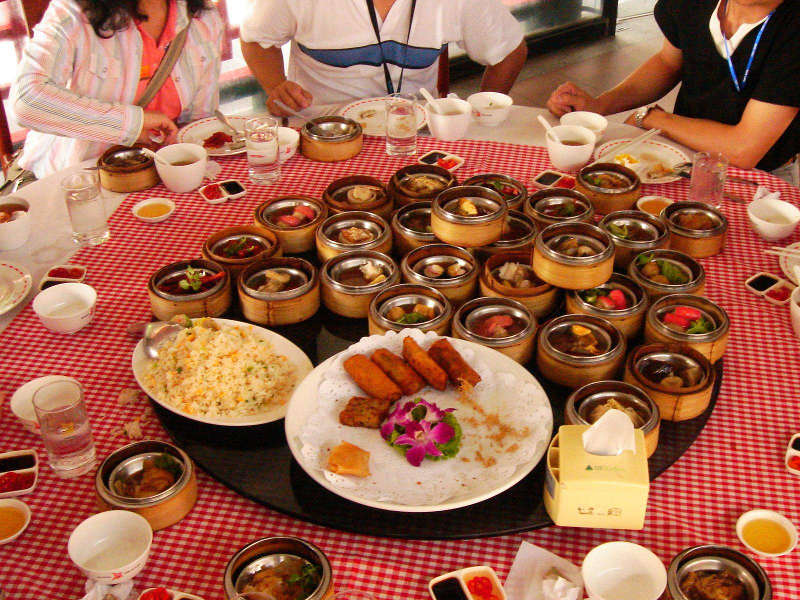 dim sum
dim sum
How to get to Yokohama's Chinatown
The nearest station is
Motomachi-Chukagai. This station is the last stop on the
Minatomirai Line, a short line that connects this area with Minato Mirai (5 minutes) and Yokohama Station (8 minutes).
Alternatively,
Ishikawachō train station is a five-minute walk from Chinatown. This station is served by the useful
JR Negishi Line, thanks to which you can easily reach Yokohama Station (7 minutes) or Sakuragicho (4 minutes).
Reach Yokohama's Chinatown on foot
Yamashita Park and the waterfront are just a few minutes walk from Chinatown. It is not difficult to get to Chinatown on foot even from the Minato Mirai area or from Sakuragicho (20/25 minutes).
Map of Yokohama's Chinatown
Guided tours, activities and other things to do
If you are planning a trip to Japan and you want to do something more than just visiting famous places and monuments, we suggest you to use
Rakuten Travel Experiences.
How to use Rakuten Travel Experiences
Rakuten Travel is a very useful website to
enrich your travel experience, especially if you are going solo or it's your first time in Japan.
Because of the language barrier (and more), in Japan it is very difficult to interact with the locals and to get off the tourist track.
Thanks to Rakuten Travel you can find a lot of interesting and sometimes unique
guided tours and activities all over Japan (and not only in Japan), that you would otherwise never be able to enjoy.
But there's more: on Rakuten Travel you can also
buy tickets for several famous attractions, events, transportation and other useful services for tourists. Last but not least, you can
reserve a table in hundreds of restaurants.
Some examples
Take a look at Rakuten Travel Experiences
You may also be interested in


